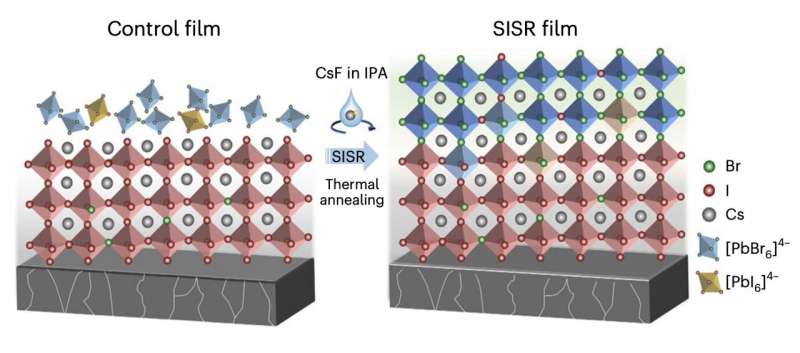A strategy to improve the efficiency and carrier lifetimes of all-inorganic perovskite solar cells

All-inorganic perovskites have recently proved to be highly promising for the development of photovoltaics (PVs), as they could potentially achieve better thermal stabilities than hybrid perovskite solar cells based on both organic and inorganic materials. Despite their possible advantages, most solar cells that are fully based on inorganic perovskites exhibit poor energy efficiencies and short carrier lifetimes.
These disappointing performances are mostly due to a loss of energy caused by non-radiative recombination, a process through which charge carriers recombine and release phonons instead of photons. The energy losses and reduced efficiencies resulting from this process have so far hindered the real-world implementation of all-inorganic perovskite solar cells.
Researchers at the Chinese Academy of Sciences recently devised a strategy that could help to improve the efficiency and extend the carrier lifetimes associated with all-inorganic perovskite solar cells. This strategy, introduced in Nature Energy, is based on an approach known as surface in situ reconstruction (SISR), which entails treating materials with specific chemicals to form new layers on their surface.
“We developed SISR strategy for inorganic perovskite by CsF treatment, which can suppress non-radiative recombination and promote hole extraction simultaneously,” Xinbo Chu, Qiufeng Ye and their colleagues wrote in their paper. “Surface defects can be effectively passivated by the introduced fluorine, and carrier lifetime was prolonged from 11.5 ns to 737.2 ns. In addition, a wider-bandgap perovskite layer can be generated as a graded heterojunction to facilitate hole extraction.”
The SISR strategy introduced by the researchers entails treating an inorganic perovskite with cesium fluoride (CsF), a chemical that can suppress the non-radiative recombination process while also promoting the extraction of holes. In their study, they specifically applied this method to CsPbIxBr3−x, an inorganic perovskite often used to create absorbers for PVs.
Chu, Ye and their colleagues then ran a series of tests aimed at evaluating the performance of an all-inorganic perovskite solar cell based on CsPbIxBr3−x that was treated following their strategy. Their findings were highly promising, suggesting that their proposed strategy had successfully improved the solar cell’s efficiency and also extended its carrier lifetimes.
“The SISR reaction mechanism was verified from both kinetic calculations and experiments,” Chu, Ye and their colleagues wrote in their paper. “A CsPbIxBr3−x solar cell with SISR achieved an efficiency of 21.02% with a high open-circuit voltage of 1.27 V and fill factor of 85.3%.”
The recent work by this team of researchers could have valuable implications for the development of stable, efficient, and reliable all-inorganic perovskite PVs. In addition to informing the development of new solar cells, it could soon inform new studies assessing the potential of other SISR strategies for limiting non-radiative recombination losses in inorganic perovskites.
While Chu, Ye and their colleagues have so far only tested their strategy on CsPbIxBr3−x, they believe that it could also be applied to other inorganic perovskites. In the future, it could thus be tested on other material samples and solar cells, to verify its generalizability.
More information:
Xinbo Chu et al, Surface in situ reconstruction of inorganic perovskite films enabling long carrier lifetimes and solar cells with 21% efficiency, Nature Energy (2023). DOI: 10.1038/s41560-023-01220-z
© 2023 Science X Network
Citation:
A strategy to improve the efficiency and carrier lifetimes of all-inorganic perovskite solar cells (2023, April 4)
retrieved 4 April 2023
from https://techxplore.com/news/2023-04-strategy-efficiency-carrier-lifetimes-all-inorganic.html
This document is subject to copyright. Apart from any fair dealing for the purpose of private study or research, no
part may be reproduced without the written permission. The content is provided for information purposes only.
For all the latest Technology News Click Here
For the latest news and updates, follow us on Google News.
